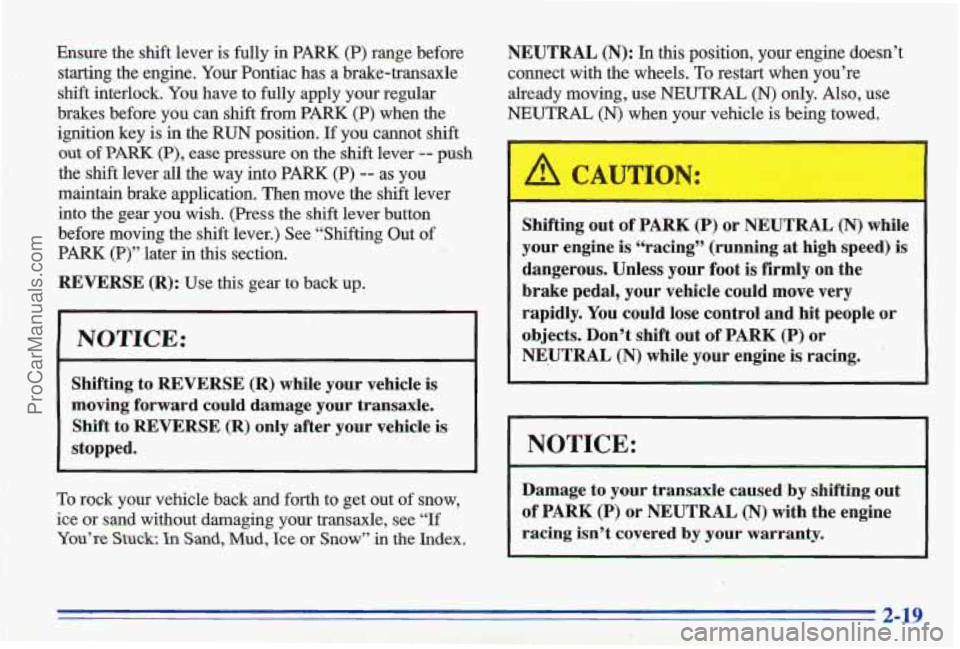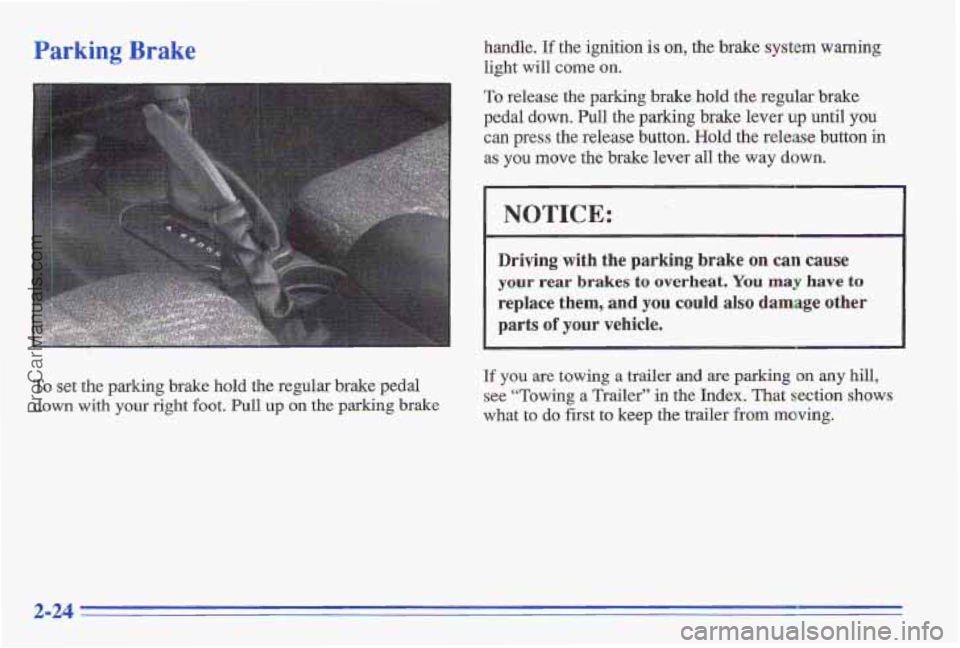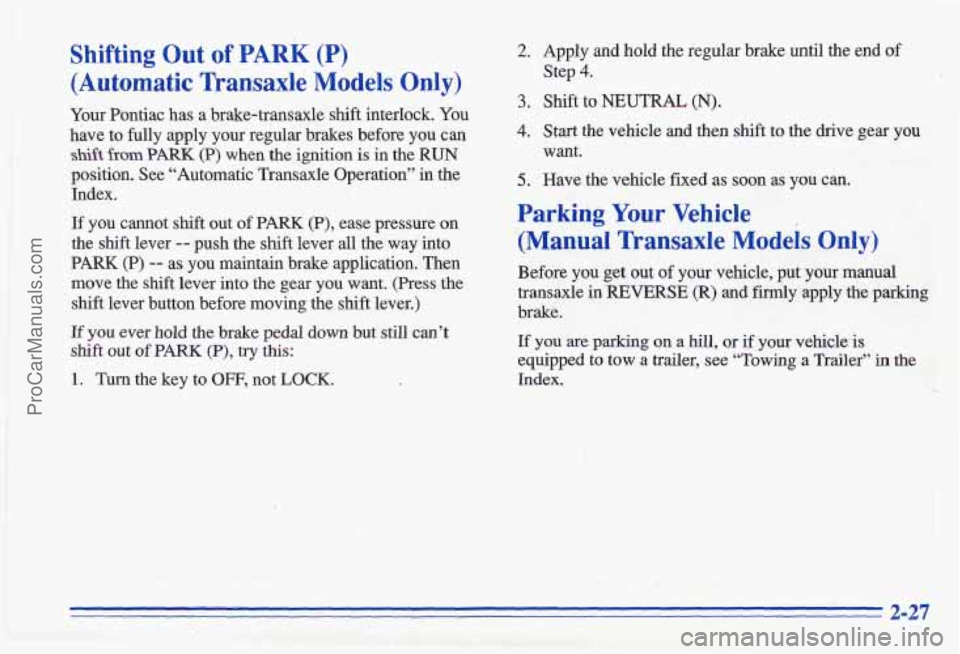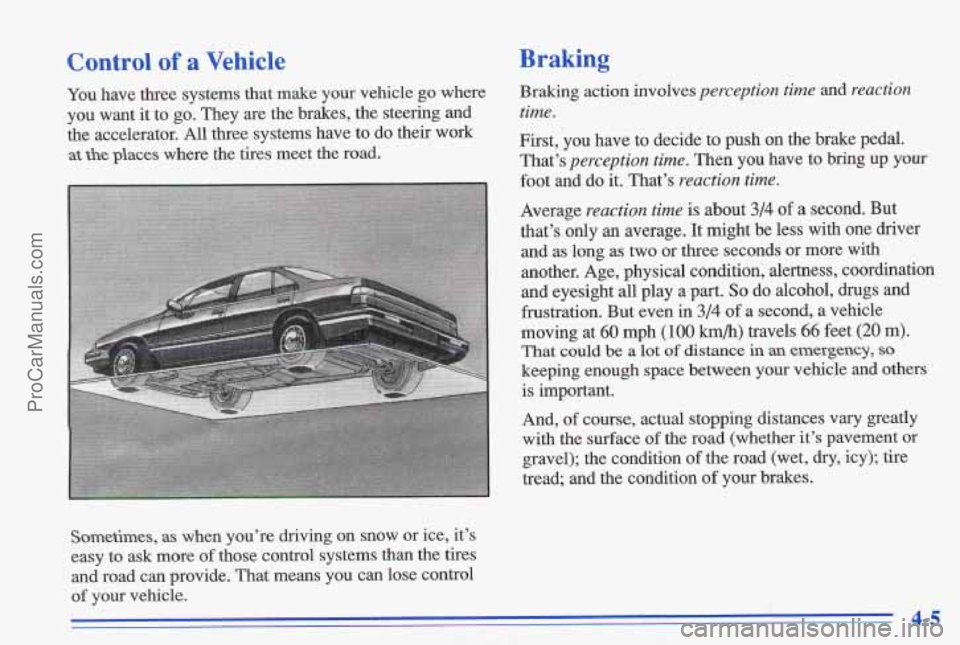1996 PONTIAC GRAND-AM brakes
[x] Cancel search: brakesPage 7 of 356

For example,
these symbols
me used on an
original battery:
POSSIBLE A
CAUTION
INJURY
PROTECT EYES BY
SHIELDING
CAUSTIC
ACID COULD BAllERY
CAUSE
BURNS
AVOID
SPARKS OR FLAMES
FLAME
EXPLODE BAllERY
These symbols
are important
for you and
yorr passengers
whenever your
vehicle is
driven:
DOOR LOCK
UNLOCK
FASTEN SEAT
BELTS
Vehicle Symbols
These are some of the symbols you may find on your vehicle.
Op
AIR BAG p
These symbols
have
to do with
your lights:
SIGNALS e
TURN
PARKING
pf
LAMPS
RUNNING
' ' 0
DAYTIME *
LAMPS *
FOG LAMPS $0
These symbols
are
on some of
your controls:
WINDSHIELD
DEFROSTER
WINDOW
DEFOGGER
VENTILATING FAN
These symbols are used on
warning and
indicator lights:
ENGINE k
COOLANT - rd
TEMP -
BRAKE (0)
ENGINE OIL
PRESSURE
ANTI-LOCK
(e)
BRAKES
Here are some
other symbols
you may
see:
FUSE
LIGHTER
m
HORN )tr
SPEAKER
b
il'
FUEL
V
ProCarManuals.com
Page 75 of 356

I
Ensure the shift lever is fully in PARK (P) range before
1 ’. I . starting the engine. Your Pontiac has a brake-transaxle !’ 2 . shift interlock. You have to fully apply your regular
brakes before you can shift from PARK (P) when the
ignition key is in the
RUN position. If you cannot shift
out of PARK (P), ease pressure on the shift lever -- push
the shift lever all the way into PARK
(P) -- as you
maintain brake application. Then move the shift lever
into the gear you wish. (Press the shift lever button
before moving the shift lever.) See “Shifting Out
of
PARK (I?)” later in this section.
REVERSE (R):
Use this gear to back up.
NOTICE:
Shifting to REVERSE (R) while your vehicle is
moving forward could damage
your transaxle.
Shift to REVERSE (R) only after your vehicle
is
stopped.
To rock your vehicle back and forth to get out of snow,
ice or sand without damaging your transaxle, see
“If
You’re Stuck: In Sand, Mud, Ice or Snow” in the Index. NEUTRAL
(N):
In this position, your engine doesn’t
connect with the wheels.
To restart when you’re
already moving, use
NEUTRAL (N) only. Also, use
NEUTRAL (N) when your vehicle is being towed.
I
Shifting out of PARK (P) or NEUTRAL (N) while
your engine
is “racing” (running at high speed) is
dangerous. Unless your foot is firmly on. the
brake pedal, your vehicle could move very
rapidly.
You could lose control and hit people or
objects. Don’t shift out of PARK
(P) or
NEUTRAL
(N) while your engine is racing. .
NOTICE:
Damage to your transaxle caused’by shifting ‘out
of PARK
(P) or NEUTRAL (N) with the engine
racing isn’t covered
by your warranty.
ProCarManuals.com
Page 80 of 356

Parkiaag.’Brake handle. If the ignition is on, the brake system warning
light will come on.
To release the parking brake hold the regular brake
pedal down. Pull
the parking brake lever up until you
can press the release button. Hold the release button in
as you move the brake lever all the way down.
Driving with the parking, brake on can cause
your rear brakes to overheat. You may have to
replace them, and you could also damage other
To set the parking brake hold the .regular brake pedal If you are towing a trailer and are parking on my hill,
see “Towing
a Trailer” in the Index. That section shows
down with Your ‘ght foot* On the parking brake what to do first to keep the bailer from moving.
2-24
ProCarManuals.com
Page 83 of 356

Shifting Out of PARK (P)
(Automatic Transaxle Models Only)
Your Pontiac has a brake-transaxle shift interlock. You
have to fully apply your regular brakes before you can
shift from PARK (P) when the ignition is in the RUN
position. See “Automatic-Transaxle Operation” in the
Index.
If you cannot shift out of
PARK (P), ease pressure wn
the shift lever -- push the shift lever all the way into
PARK (P)
-- as you maintain brake application. Then
move the shift lever into the gear you want. (Press the
shift lever button before moving the shift lever.)
If you ever hold the brake pedal down but still can’t
shift
out of PARK (P), try this:
1. Turn the key to OFF, not LOCK. , ,<. j:~+!-,. , , ‘(, . .I. ”
,..I_ . , , . P ., , :. a -9 -- ....,. 4 -’. .:‘.I..: .,:- ;.
i.. ’ .--4 ..
2.
3.
4.
5.
Apply and hold the regular brake until the end of
Step
4.
Shift to NEUTRAL (N).
Start the vehicle and then shift to the drive gear you
want.
Have the vehicle fixed
as soon as you can.
Parking Your Vehicle
(Manual Transaxle Models Only)
Before you get out of your vehicle, put your manual
transaxle in’REVERSE
(R) and firmly apply the-parking
brake.
If you are parking on a hill, or if your vehic1e.k
equipped to tow
a trailer, see “Towing a Trailer” in the
Index.
ProCarManuals.com
Page 91 of 356

Cruise Control (Option)
With cruise control, you can maintain a speed of about
25 mph (40 h/h) or more without keeping your foot on
the accelerator. This can really help on long trips. Cruise
control does not work at speeds below about
25 mph
(40 hh).
When you apply your brakes or push the clutch pedal
(if you have a manual transaxle), the cruise control
shuts
off.
Cruise control can be dangerous where you
can't drive safely at a steady speed. So,
don't use your cruise control on winding
roads or in heavy traffic.
slippery roads. On such roads, fast changes
in tire traction can cause needless wheel
spinning, and
you could lose control. Don't
use cruise control on slippery roads.
0 Cruise control can be dangerous on
2-35
ProCarManuals.com
Page 113 of 356

Your brake system may not be working properly
if the brake system warning light is on. Driving
with the brake system warning lighlt on can lead
to an accident.
If the light is still on after you’ve
pulled off the road and stopped carefully, have
the vehicle towed
for service.
When the ignition is on, the brake system warning light
will also come
on when you set your parking brake. The
light will stay on if your parlung brake doesn’t release
fully.
If it stays on after your parking brake is fully
released,
it means you have a brake problem.
Anti-Lock Brake System Warning Light
With the anti-lock brake
system,
this light will come
on when you
start your
engine
and it will stay on for
three seconds. That’s normal.
If the light stays on, turn the ignition off. Or, if the light
comes on when you’re driving, stop
as soon as possible
and turn the ignition off. &. 1
Then start the engine again to reset the system. If the .I ‘I
light still stays on, or comes on again while you’re
driving, your Pontiac needs service.
If the regular brake
system warning light isn’t
on, you still have brakes, but
you don’t have anti-lock brakes.
If the regular brake
system warning light is also on, you don’t have anti-lock
brakes and there’s a problem with your regular brakes. See “Brake System Warning Light” earlier
in .this part.
2-57
ProCarManuals.com
Page 153 of 356

Control of a Vehicle
You have three systems that make your vehicle go where
you want it to
go. They are the brakes, the steering and
the accelerator. All three systems have to do their work
at the places where the tires meet the road.
Sometimes, as when you’re driving on snow or ice, it’s
easy to
ask more of those control systems than the tires
and road can provide. That means you can lose control
of your vehicle.
Braking
Braking action involves perception time and reaction
time.
First, you have to decide to push on the brake pedal.
That’s
perception time. Then you have to bring up your
foot and do it. That’s reaction time.
Average reaction time is about 3/4 of a second. But
that’s only an average. It might be less with one driver
and as long as two or three seconds or more with
another. Age, physical condition; alertness, coordination
and eyesight all play a part.
So do alcohol, drugs and
frustration. But even in
3/4 of a second, a vehicle
moving at
60 mph (100 h/h) travels 66 feet (20 m).
That could be a lot of distance in an emergency, so
keeping enough space between your vehicle and others
is important.
And,
of course, actual stopping distances vary greatly
with the surface
of the road (whether it’s pavement or
gravel); the condition
of the road (wet, dry, icy); tire
tread; and the condition
of your brakes.
4-5 ,. I ProCarManuals.com
Page 154 of 356

Avoid needless heavy braking. Some people drive in
spurts -- heavy acceleration followed by heavy
braking -- rather than keeping pace with traffic. This is a
mistake. Your brakes may not have time to cool between
hard stops.
Your brakes will wear out much faster if you
do a lot of heavy braking. If you keep pace with the
traffic
and allow realistic following distances, you will
eliminate a lot of unnecessary braking. That means
better braking and longer brake life.
If your engine ever stops while you’re driving, brake
normally
hut don’t pump your brakes. If you do, the
pedal
may get harder to push down. If your engine
stops, you will still have some power brake assist. But
you
will use it when you brake. Once the power assist is
used up, it m’ay take longer to stop and the brake pedal
will be harder to push.
5: , ‘
AntbLsck Brakes
Your vehicle has anti-lock brakes (ABS). ABS is an
advanced electronic braking system that will help
prevent a braking
skid.
When you start your engine, or when you begin to drive
away,
your anti-lock brake system will check itself. You
may hear a momentary motor or clicking noise while
this test is going
on, and you may even notice that your
brake pedal moves
a little. This is- normal.
(e)
If there’s a problem with the
anti-lock brake system,
this
warning light will stay on.’
See “Anti-Lock Brake
System Warning Light”
in
the Index.
4-6
ProCarManuals.com